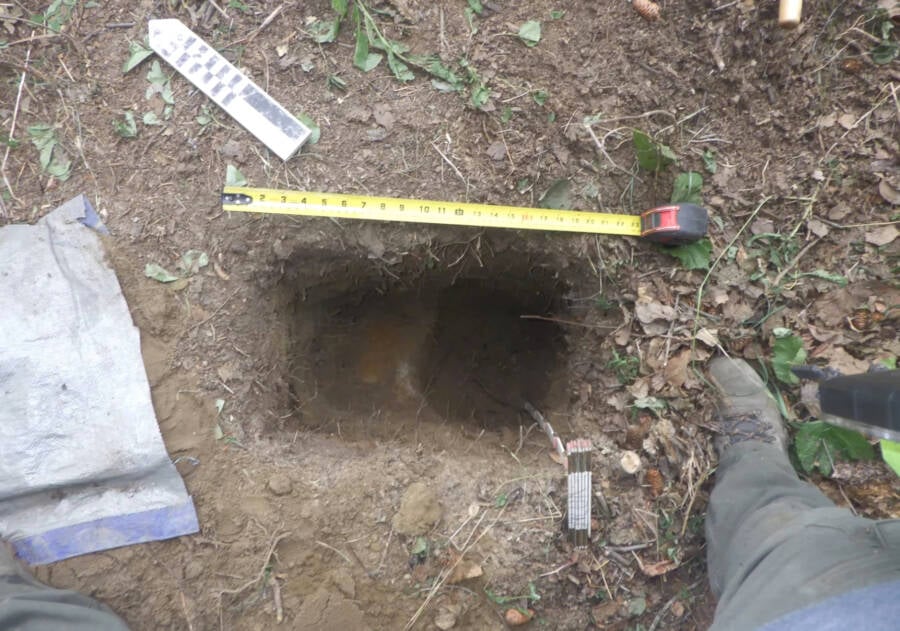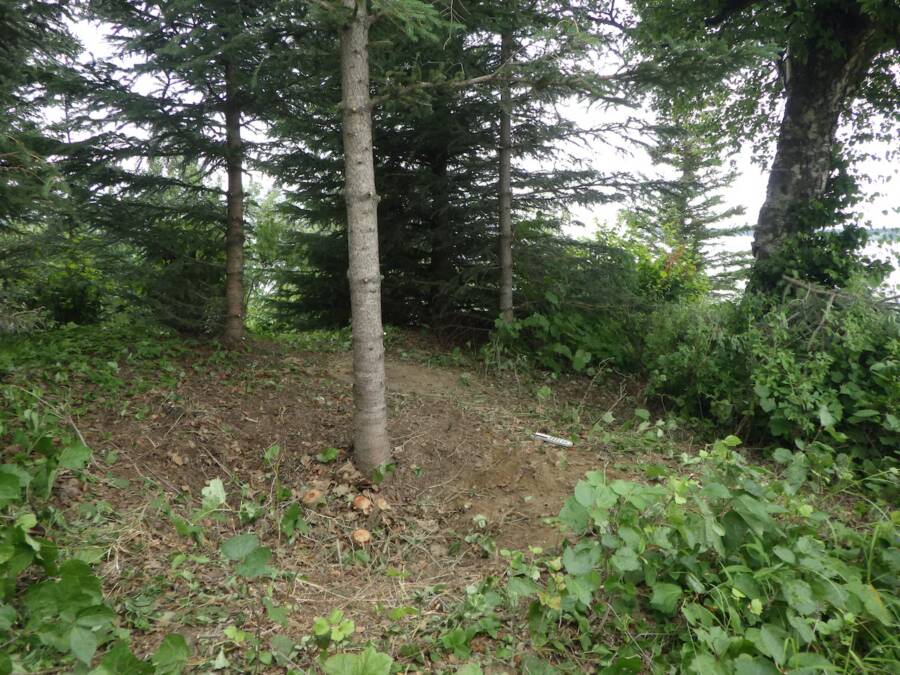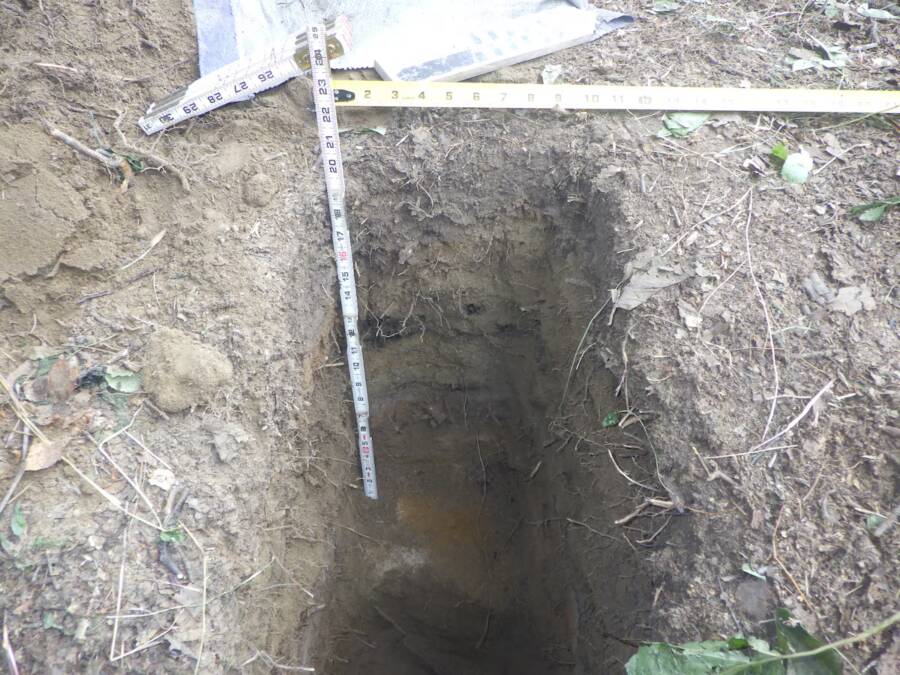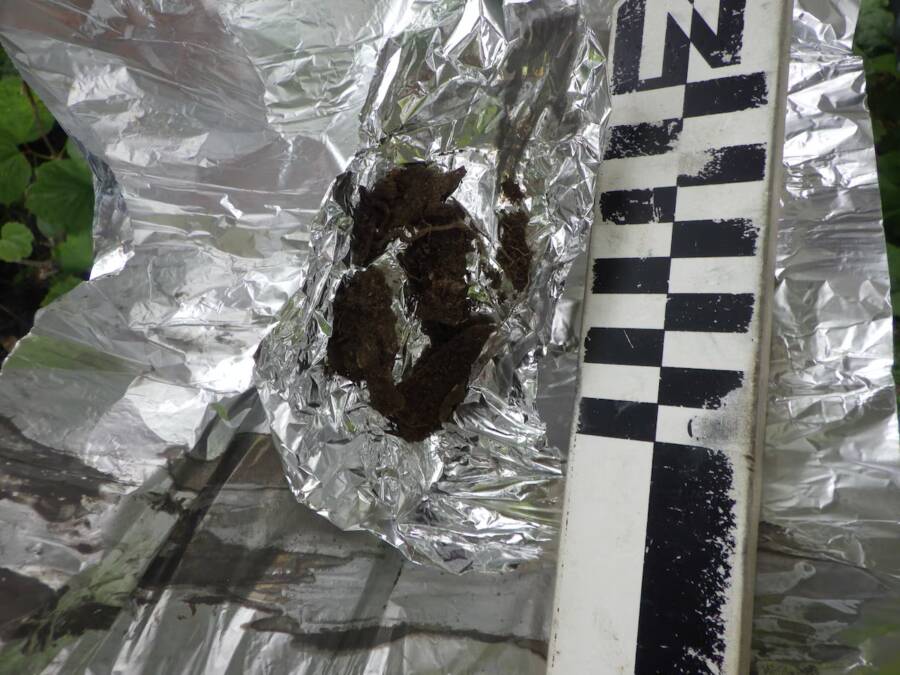Dug 3.5 feet deep and lined with birch bark and grass, this carefully constructed pit would have been ideal for storing meat and fish — and researchers actually found 1,000-year-old traces of caribou and moose still inside.

U.S. Air ForceOn a hill overlooking Upper Cook Inlet, researchers uncovered this underground food cache used by the Dene people 1,000 years ago.
Military officials recently announced the discovery of a 1,000-year-old Indigenous food cache near a narrow stretch of the Gulf of Alaska in 2024. The cache was located along a well-known trail long used by local native groups that extends northward out of modern-day Anchorage.
Measuring 3.5 feet deep, this cache pit was lined with birch bark and grass, and was meant to preserve fish, meat, and berries in the face of Alaska’s often intense seasonal weather patterns. The cache was created by the region’s Dene people around 1,000 years ago, according to initial radiocarbon dating.
Researchers now say that this discovery provides a new perspective on the region’s Indigenous history and illuminates additional ways to protect that legacy going forward.
The Discovery Of An Indigenous Food Cache On A Hill Overlooking Alaska’s Knik Arm

Joint Base Elmendorf-RichardsonThe food pit is located along an important trail traditionally used by the Indigenous Dene people to travel between Upper Cook Inlet and the Matanuska and Susitna valleys.
In June 2024, archaeologists from the Joint Base Elmendorf-Richardson (JBER) discovered the 1,000-year-old cache near Upper Cook Inlet on a hill of spruce and birch overlooking the Knik Arm, a narrow stretch of the Gulf of Alaska. In a December press release, military officials described the cache as a kind of root cellar, used to store food and preserve it throughout Alaska’s seasonal weather extremes.
“This is the oldest known site on the east side of Upper Cook Inlet, and further substantiates Dena’ina and Ahtna oral traditions that JBER and the surrounding area have been used for a very long time,” said Margan Grover, archaeologist and JBER cultural resource manager.
Similar examples have been found in the past in other Alaskan regions, particularly the Matanuska and Susitna valleys or on the Kenai Peninsula. However, it is far rarer to find Dene cache pits or house sites near Anchorage, largely due to the area’s history of human development and its less stable ground conditions. For such a site to survive for nearly 1,000 years in this region is truly remarkable.

Joint Base Elmendorf-RichardsonThe pit was 3.5 feet deep and lined with birch bark and layers of grass.
“When we got the results back that said it was 960 years, plus or minus 30, we were shocked,” Liz Ortiz, an archaeologist and cultural resources program manager with JBER, told local news station KNBA. “[We] were jumping up and down in our cube in tears. It was very, very exciting.”
Ortiz and fellow researchers believe the cache’s discovery could provide an important learning opportunity regarding the region’s Indigenous history.
“Anchorage is a new town. You know, 1914 is when it’s first established,” Grover said. “But there are people who were here much longer than that, and they were amazing stewards of this land, and so we have to make sure we acknowledge that.”
How This Dene Food Cache Is Offering New Insights Into Alaska’s Indigenous History
The site where the cache was found has a long history of association with the Dena’ina and Ahtna people, Ortiz explained. It lies along a traditional trail used to travel between what’s now the Anchorage region and the Matanuska and Susitna valleys, where people would remain throughout the spring and summer to catch and preserve salmon.
During these warm months, Indigenous people would also stay in traditional houses known as nichil, which lined the bluff and beach along Upper Cook Inlet. Here, they also erected smokehouses, important buildings for ceremonies, worship, and preserving meat.
While this is not the oldest site of its kind in Alaska — some others have been dated back 14,000 years — it is still an important focal point for study that allows researchers to learn more about the Dene. To this day, half of Alaska’s population today lives within traditional Dene lands. Unfortunately, many of those areas have been disturbed, leaving fewer and fewer opportunities to examine sites such as this.

Joint Base Elmendorf-RichardsonInitial radiocarbon dating shows that meat from moose and caribou were stored in the pit.
“I want this to be an opportunity for people to understand who the Dene of Knik Arm are and how their ancestors lived on the land that is now JBER and Anchorage,” said Grover. “The Dene have a sophisticated understanding of their environment that allowed them to thrive for generations… They actively managed the resources in their territory, doing small things to enhance what nature already provides.”
While most of the site was demolished by the military in 1942, the newly found cache miraculously survived, making it one of the few Dene remnants still left undisturbed. The JBER team said they plan to revisit the cache and conduct further analysis in cooperation with members of the Chickaloon Village Traditional Council and Native Village of Eklutna to determine which methods would be most productive at the site.
“There are things that we know inherently from what was passed down about living in a place, but there are other things that these archeological sites tell us about the past… and about hardship,” said Angela Wade, a Chickaloon Village tribal citizen and tribal historic preservation officer.
“I feel like every site that we learn about, every site that we can further investigate, is a piece of our history that was potentially lost. So this is kind of regaining some of the history that we were separated from.”
After learning about the discovery of this 1,000-year-old food cache, learn more about Native American history through our gallery of 44 colorized photos from 100 years ago. Then, read about nine of Native American history’s most powerful warriors.





